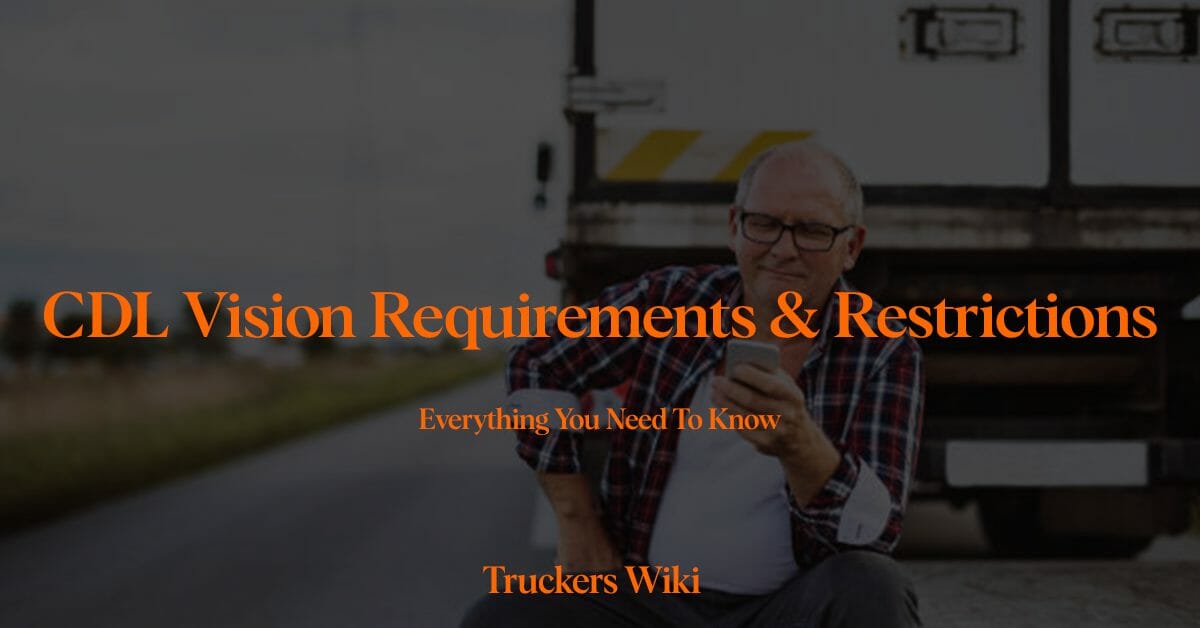
Table of Contents
What are the CDL Vision Requirements and Restrictions
The Department of Transportation (DOT) has established vision standards – CDL Vision Requirements and Restrictions for commercial drivers to ensure they have adequate visual acuity and peripheral vision while operating commercial vehicles.
CDL Restriction for Eyeglasses or Corrective Lenses
If an individual requires eyeglasses or corrective lenses to meet the minimum vision standards, they will be issued a CDL restriction code indicating the need for visual aids. This restriction code is denoted as “E” or “L” on the CDL, depending on the state’s coding system.
Requirements for CDL Vision Standards
To meet the vision requirements for a CDL, the following guidelines are generally applied.
Visual Acuity: The minimum visual acuity standard typically requires a visual acuity of at least 20/40 in each eye, with or without correction.
If corrective lenses are necessary to achieve this level of visual acuity, the CDL will carry the restriction code. This code only means that you will have to wear eyeglasses or correction lenses while driving.Peripheral Vision: A driver must have a horizontal field of vision of at least 70 degrees in each eye. This means they should be able to see objects without turning their head more than 35 degrees left or right.
Can You Be a Truck Driver if You Don’t Have Perfect Vision
Yes, you can become a truck driver even if you don’t have perfect vision.
Impact on Commercial Drivers
CDL restrictions for eyeglasses or corrective lenses are in place to ensure that commercial drivers have optimal vision for safe operation of their vehicles. By complying with these restrictions, drivers can maintain their licenses and continue to perform their duties while prioritizing safety on the road.
Compliance with CDL Restrictions
Commercial drivers who require eyeglasses or corrective lenses must wear them at all times while operating a commercial vehicle. Failure to comply with this requirement may result in penalties, fines, or even suspension of the CDL.
It is essential for commercial drivers to undergo regular eye examinations to ensure their vision remains within the required standards. Any changes in vision or prescription should be promptly addressed to update the necessary corrective lenses.
List of State Codes
Here are the CDL restriction codes related to eyeglasses or corrective lenses for a few states**:
- Alabama: B, A (OLD)
- Alaska: None specified
- Arizona: E
- Arkansas: None specified
- California: E
- Colorado: None specified
- Connecticut: E
- Delaware: E
- Florida: B
- Georgia: B
- Hawaii: None specified
- Idaho: None specified
- Illinois: B
- Indiana: None specified
- Iowa: None specified
- Kansas: None specified
- Kentucky: None specified
- Louisiana: None specified
- Maine: None specified
- Maryland: None specified
- Massachusetts: None specified
- Michigan: None specified
- Minnesota: None specified
- Mississippi: B
- Nevada: B
Notice: The list of codes is currently being updated.
Notice**: Some states may not specifically designate restriction codes for eyeglasses or corrective lenses on their CDLs. It’s important to check with the appropriate licensing agency or Department of Motor Vehicles (DMV) in each state for the most accurate and up-to-date information regarding CDL restriction codes related to eyeglasses or corrective lenses.
Learn about all CDL requirements here.
IALVS has a list of vision requirements by state, you can check it out here.
Listen to The Article Here
Audio Article CDL Vision Requirements and Restrictions What are the
Last modified: August 25, 2023

